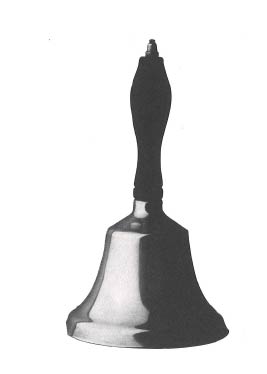Updated April, 2025
From time to time all of us who plan worship need some new ideas and triggers that will spark our creativity. Using handbells in worship can be such a spark. I like to think of bells as a seasoning to the “meat and potatoes” of the liturgy. Used with discretion, bells can be an outstanding asset to engage the congregation’s senses in worship.The sound of bells intrinsically brings a sense of awe and “other-worldliness” to a culture that is so grounded in the “here and now.” A finely crafted bell, well played, can produce a sound that is beautifully mysterious. And when a multigenerational group of people work cooperatively to produce it, they develop both individual skills and group musical sensitivity. Best of all, they experience fellowship and caring for each
other as members of the body of Christ. In the sharing of a common task and goal the community of a bell choir represents the larger picture of Christ’s body, the church.
Challenges
Certainly there are challenges to using bells in worship. Space and acoustical limitations can hinder their effectiveness. The tension of balancing technical skill levels of individual ringers with the desire to give a cohesive and beautiful musical offering is always challenging. As with other choirs, it is essential for each individual to commit to the group and to faithfully attend rehearsal times. The effectiveness of the group as a prompter of God-honoring and life-enriching worship will be shaped by its degree of commitment.
But don’t let these challenges keep you from using handbells to enrich your congregation’s worship. Following are a number of suggestions for doing just that. Some are best used with individuals, others with an entire bell choir. Some will need to be rung by experienced ringers; others can be rung by novices. All of them could be used with hand chimes or bells. Children and youth could lead very well with some coaching and direction. In addition, Hal Hopson’s The Creative Use of Handbells in Worship (Hope Publishing) is an invaluable resource for handbell accompaniment suggestions for hymns.

Congregational Song Accompaniment
- Use upper handbells to play the written descants from the hymnal.
- Compose instant descants by playing the alto or tenor line of the hymn with the highest bells.
- Play from the hymnal on selected stanzas, transcribing and doubling octaves for fuller sound. Sometimes directors will need to write this out for ringers; more experienced ringers can play off an enlarged hymnal page. Chordal accompaniments are easily adapted to handbells.
- Hymns based on plainsong or the pentatonic scale can be accompanied by handbells, either playing open fifth chords or randomly ringing the first, fifth, second, third, and sixth tone of the pentatonic scale. These tones could be rung together or consecutively. The bells could begin, followed by a single voice, instrument, or congregation singing on cue. Consider having the bells encircle the congregation or being evenly placed throughout the sanctuary. Another option is to free-ring the first, fifth, second, and fourth tones of the scale. This works very well with the hymn “O Come, O Come, Immanuel.”
- Bells can play the ostinato patterns typified by Orff instrumentation—as seen in “Go Now in Peace,” set in Psalter Hymnal 317.
- Bells can play interludes between stanzas or fanfares preceding and concluding a hymn. The John Dunstable organ fanfare on deo gratias arranged for handbells works with the hymn “O Love, How Deep, How Broad, How High.”
- Bells can reinforce the “alleluias” in a given hymn as in “All Creatures of our God and King” and “Christ the Lord Is Risen Today.” Also consider playing the “alleluias” as a fanfare or interlude between stanzas.
- Concertatoes for bells, congregation, choir, and organ are available that can be easily adapted to suit your congregation.
Accompanying a Choir
- Play opening pitches to unaccompanied anthems or responses with bells.
- A chord consisting of open fifths at the beginning of choral phrases will help to keep an insecure choir in tune without sounding like a crutch.
- A simple arpeggiated accompaniment can effectively accompany a choir. This works very well with children’s voices. Consider using “May the Lord Bless You” (Songs for LiFE 80) as a choral benediction or as a response to a profession of faith.
Other Ideas
- Processionals: Incorporate short, easily memorized patterns or chord structures for processionals or introductions to hymns.
- Tolling: A toll involves the lower bells playing one note or an open fifth chord repeatedly and very slowly. A toll can also involve the repetition of a short pattern of notes—again at a very slow pace. This is effective when used during moments of deep solemnity in a service, particularly during the season of Lent. Tolling is effective on “What Wondrous Love” and “Ah, Holy Jesus” or as an accompaniment to the exit of the Christ candle at a Tenebrae service.
- Pealing: Pealing involves a repeated pattern of upper melody notes rapidly rung or cluster chords repeated as exclamations to celebrative events in worship. A repeated pealing of a descending scale on “Joy to the World” on Christmas morning or the vibrant sound of a cluster chord at the lighting of the Christ candle in Easter season could be very moving.
- Solo Ringing: A hymn whose melody is rung unaccompanied can be both haunting and meditative. This is particularly powerful when used during the passing of the elements at the Lord’s Supper or as an accompaniment to Scripture reading.
- The placement of bells matters. Emphasize a reflective setting by playing bells from the back of the sanctuary. A celebrative leading of congregational song can be heightened by being able to see the bells from the front.
